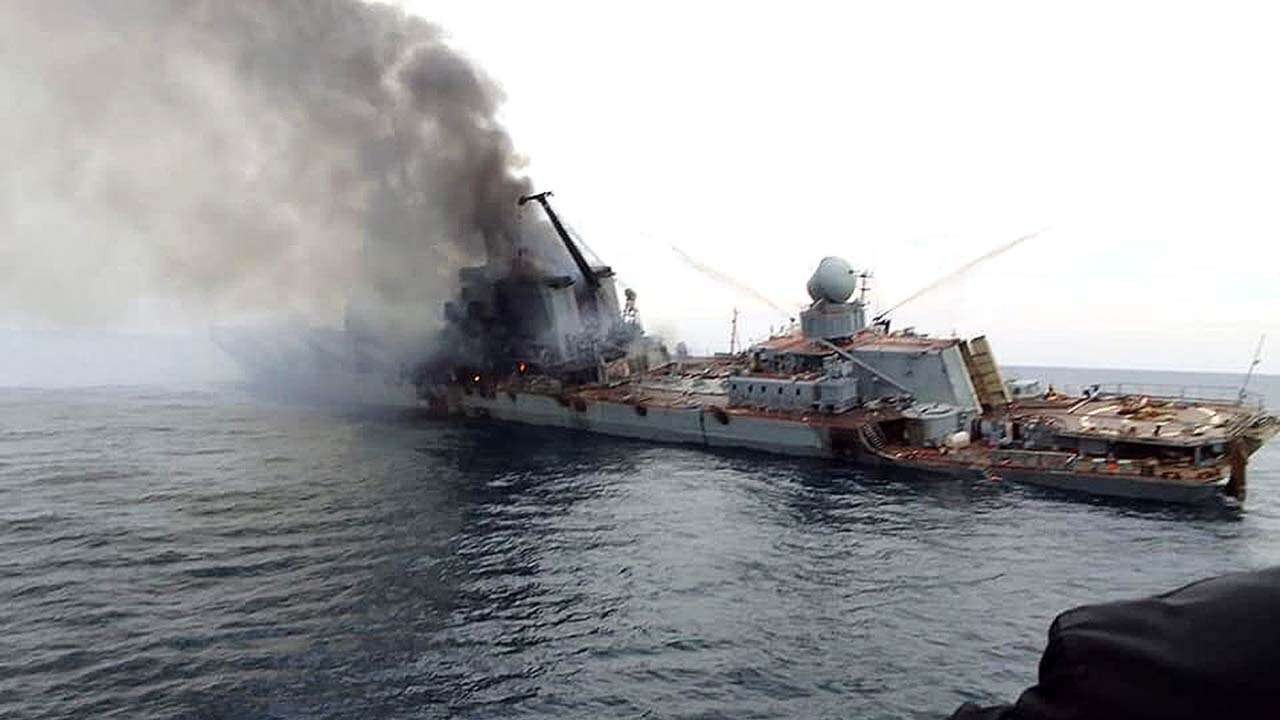On April 13 last year, Ukraine scored a big combat win against the Russian forces when it fired two Neptune anti-ship cruise missiles at the Russian flagship cruiser – Moskva, leading to the vessel’s sinking. A journalist posted a video on its first anniversary showing how it was done.
China Tested New DF-27 Hypersonic ICBM That Can Penetrate Mainland US Defense Systems — Leaked Info
Ukraine War: Russia ‘Chokes’ In Rolling Out Cutting-Edge Weapons To Battle NATO-Backed Kyiv As Exodus Hits Moscow’s Plan
Renowned Ukrainian Journalist, Yurii Butusov, took to Facebook to post a video showing the launch of the two Ukraine-manufactured RK-360 Neptune subsonic anti-ship cruise missiles that hit the flagship of Russia’s Black Sea Fleet, the infamous cruiser Moskva, Ukrainska Pravda reported.
The video was accompanied by a caption: “Historical video of the greatest naval victory after the Second World War, which we received from sources close to the Luch Design Bureau. Exactly one year ago, on April 13, 2022, at 14:10, a crew of the RK-360 Neptune anti-ship missile system of the Armed Forces of Ukraine launched two missiles at the missile cruiser Moskva, the flagship of the Black Sea Fleet of the Russian Federation.”
According to the details published by the report, the Russian cruiser unintentionally entered the range of Ukrainian missiles. As soon as it was discovered, two Neptunes were launched at around 16:00, and they each flew in the direction of the Moskva one after the other.
One of the security officials texted UP journalists that night: “The Moskva Is Done.”
Besides the scintillating video that comes one year after sinking the vessel that became the symbol of the Ukrainian struggle against the invasion, Kyiv’s authorities also published a new artwork commemorating the battlefield win.
On April 14, the official Twitter handle of Ukraine’s Defense Ministry published an artwork by Andriy Dankovych showing the launch of the Neptune missile. The tweet read: “Neptune bids the cruiser ‘Moskva’ farewell.” The artwork was widely shared among netizens, some remembering the watershed event as “Moskva Day.”
Neptune bids the cruiser "moskva" farewell.
?️ by Andriy Dankovych pic.twitter.com/teYRmINRYD
— Defense of Ukraine (@DefenceU) April 14, 2023
Earlier, in the aftermath of the Moskva attack, Ukrainian artist Borys Hrokh drew a sketch showing a Ukrainian soldier in front of the Russian Black Sea flagship Moskva and shouting the now-iconic phrase “Russian warship, go f**k yourself.” As reports suggest, these were the words shouted by Ukrainian soldiers to the Moskva Cruiser while defending Snake Island.
The sinking of the Russian cruiser was touted as revenge by Ukraine for the Russian takeover of Snake Island. Moskva was instrumental in capturing Snake Island by Russian troops, as it gave the rest of Russia’s Black Sea fleet, which included 20 or more warships and submarines, the ability to defend itself from the air and the sea.

Moskva Sinking Was A Watershed For Ukraine
On April 13, 2022, the 11,490-ton SLAVA Class cruiser built in the Soviet Union, the Moskva, went down shortly after being heavily damaged by two Ukrainian Neptune coastal anti-ship cruise missiles.
There have been claims that Ukraine received assistance from its Western allies in locating the ship after it sank. The Ukrainian military used a Bayraktar TB2 drone to confirm the ship’s damage after Neptune missiles struck it.
Ukraine, meanwhile, has a totally different account of what happened. According to the Kyiv version, the Ukrainian forces could independently locate and identify the Moskva cruiser in the Black Sea without any external assistance.
According to the Ukrainian version, the weather was bad on April 13, with thick clouds obscuring the sky over the Black Sea near Ukraine’s shore. The clouds had started forming only a few kilometers above the sea, which meant that neither an optical satellite nor any aerial device could see anything.
Additionally, over-the-horizon radar, which could detect objects hundreds to thousands of kilometers beyond the radar horizon and beyond which normal radar cannot detect targets, was unavailable to Ukrainians at the time.

Ordinary radars used by the Neptune missile complex operator in the Odesa region could only see up to 18 kilometers away. Since the Russians knew this critical Ukrainian shortcoming, they decided it was safe to station the Moskva around 120 kilometers from the Ukrainian coast.
When this ordinary Ukrainian radar surprisingly spotted the Moskva, the ship was traveling at least 100 kilometers outside the radar’s detection range. After some deliberations and delays, the operator of the Neptune missile complex finally gave the go-ahead to launch the missile.
Since the Moskva had assisted in the seizure of Snake Island, its absence caused the Russian fleet to be forced away from the Ukrainian coast. Thus, the cruiser’s sinking was a massive loss for Moscow.
Air Defense expert Andy Netherwood told The Guardian, “Think of it as an unsinkable destroyer. If you place radar and surface-to-air missile systems there, it allows you to dominate the airspace in the northern Black Sea, including the strategically important approach to Odesa.”
Notably, the Moskva incident also spotlighted Ukraine’s homegrown Neptune anti-ship missile system that was inducted into the service by the Ukrainian military only months before Russia launched a full-scale invasion of Ukraine in February 2022.
Most importantly, however, the sinking of the Russian flagship became a symbol of resistance for Ukraine’s armed forces that were preventing the march of Russian troops occupying their territories in a bloody onslaught.
- Contact the author at sakshi.tiwari9555@gmail.com
- Follow EurAsian Times on Google News




